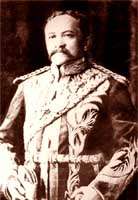Pangkor Treaty of 1874
The Pangkor Treaty of 1874 was a treaty signed between Great Britain and the Sultan of Perak. Signed on 20 January 1874, on HMS Pluto, off the coast of Perak. The treaty is significant in the history of the Malay states as it legitimised British control of the Malay rulers and paved the way for British imperialism in Malaya. It is the result of a multi-day conference (13 to 20 January 1874) organized by Andrew Clarke, the Governor of the Straits Settlements to solve two problems: (a) the Larut War; and (b) Sultanship in Perak.[1]
Precedence

Perak was a major tin producer throughout the nineteenth century, leading Britain, which had already colonised Penang, Malacca and Singapore, to consider Perak of significant importance. However, local strife, collectively known as the Larut Wars (1861–1874), between the local Malay elites and frequent clashes between Chinese secret societies disrupted the supply of tin from the mines of Perak.
In 1871, Sultan Ali of Perak died. Raja Abdullah, as Raja Muda or heir apparent, should have succeeded to the throne, but because he had not been present at the burial of the late Sultan Ali, Raja Bendahara, Sultan Ismail was proclaimed Sultan of Perak instead. At around the same time, two Chinese secret societies, known as Ghee Hin led by Chin Ah Yam and Hai San led by Chung Keng Quee, constantly waged battle against each other for control of the tin mines.
Summary of the conference
The Chinese chiefs arrived on January 13 (Tuesday), the Hai Sans group is accompanied by Swettenham, while the Ghee Hins group is escorted by Pickering. Mantri Ngah Ibrahim arrived the next day (January 14), escorted by his lawyer R. C. Woods and his security chief T. C. Speedy. Raja Muda Abdullah and the Malay chiefs, on the other hand, arrived on January 15. The afternoon session (circa 3:30 pm) of January 16 (Friday) is essentially a one-to-one meeting between Mantri Ngah Ibrahim and Clarke, in which Clarke highlighted to the Mantri that the problem in Larut is a direct consequence of his vacillating policy. The second day of the conference (January 17) is for Clarke to meet with all the Malay chiefs, in which the voices of the Malay chiefs were individually heard and weighed before the candidate for the Sultanship is sealed. January 18 is a Saturday and no business was conducted. On January 19, the draft treaty was ready, and it was read aloud and discussed with the Malay chiefs, and then finally on January 20, the Treaty of Pangkor was officially sealed in the afternoon session of the concluding day. (Actually in the morning session of January 20, another agreement between Clarke and the Chinese chiefs was signed, i.e. Bond of $50,000 to Keep the Peace)
Agreement
Raja Abdullah later asked the British for help in solving these two problems. In her book "The Golden Chersonese and The Way Thither" (Published 1892 G.P. Putnam's Sons) Victorian traveller and adventuress, Isabella Bird (1831–1904), describes how Raja Muda Abdullah as he then was turned to his friend in Singapore, Tan Kim Ching. Tan, together with an English merchant in Singapore drafted a letter to Governor Sir Andrew Clarke which Abdullah signed. The letter expressed Abdullah's desire to place Perak under British protection, and "to have a man of sufficient abilities to show (him) a good system of government." On 26 September 1872 Chung Keng Quee had already presented a petition, signed by himself and 44 other Chinese leaders, seeking British interference following the attack of 12,000 men of Chung Shan by 2,000 men of Sen Ning. (The Petition.) The British immediately saw this as a great opportunity to expand its influence in Southeast Asia and strengthened its monopoly on tin. As a result, the Pangkor Treaty of 1874 was signed.
The Malay translation of the treaty was prepared by Frank Swettenham and Mohamed Said, the official interpreter (Munshi) for the Straits Settlements.[2]
Terms and conditions
The agreement dictated:
- Raja Abdullah was acknowledged as the legitimate Sultan to replace Sultan Ismail who would be given a title and a pension of 1000 Mexican pesos a month.
- The Sultan would receive a British Resident whose advice had to be sought and adhered to in all matters except those pertaining to the religion and customs of the Malays.
- All collections and control of taxes as well as the administration of the state would be done in the name of the Sultan, but the Sultan was to govern according to the advice and consent of the Resident.
- The Minister of Larut would continue to be in control but would no longer be recognised as a liberated leader. Instead, a British officer, who would have vast authority in administering the district, would be appointed in Larut.
- The Sultan, and not the British government, would pay the salary of the Resident.
- Perak ceded Dinding and Pangkor Island to Britain. Perak also transferred Sungai Acheh and some areas on the southern banks of the Krian River to Seberang Perai (Straits Settlements).[3]
Result
Raja Ismail did not attend the meeting arranged between Sir Andrew Clarke and Raja Abdullah. Raja Ismail obviously did not recognise the agreement but had no choice as he was faced with the alliance between Raja Abdullah and the British. As a result, Raja Abdullah was made Sultan, and Sir James W.W. Birch was appointed as Perak's first British Resident after the treaty came into force.
Following this precedent, the British actively became involved in three other Malay states: Negeri Sembilan, Selangor and Pahang. These states, along with Perak, were later reorganised into the Federated Malay States.
See also
- British Malaya topics
References
- Khoo Kay Kim, and Andrew Clarke, "The Pangkor Engagement of 1874." Journal of the Malaysian Branch of the Royal Asiatic Society 47.1 (225) (1974): 1-12 online.
- Swettenham, Frank (1941). Footprints in Malaya. London, New York, Melbourne: Hutchinson & Co. p. 33.
- "Documents Archive - Pangkor Engagement of 1874". National University of Singapore. Retrieved 10 January 2019.
Further reading
- Kim, Khoo Kay, and Andrew Clarke, "The Pangkor Engagement of 1874." Journal of the Malaysian Branch of the Royal Asiatic Society 47.1 (225) (1974): 1-12 online.
